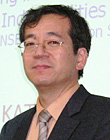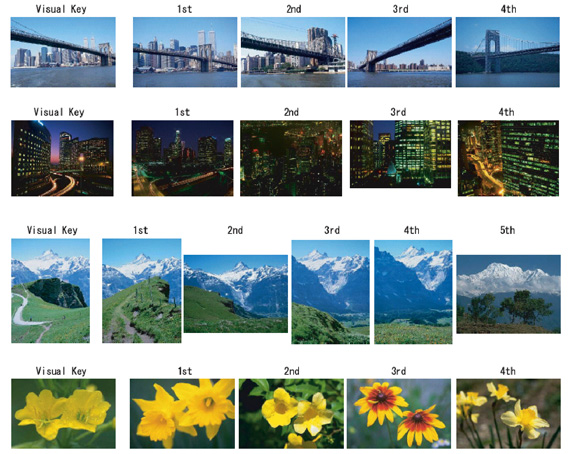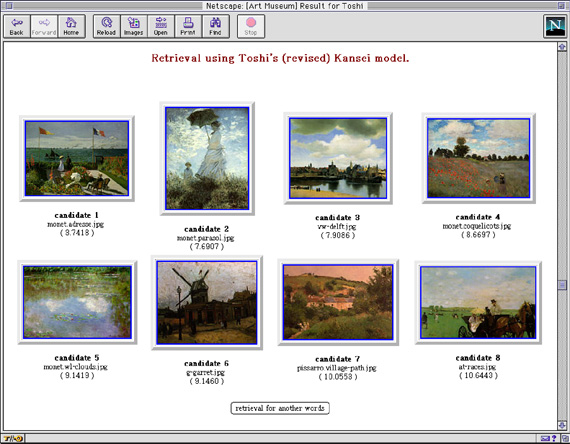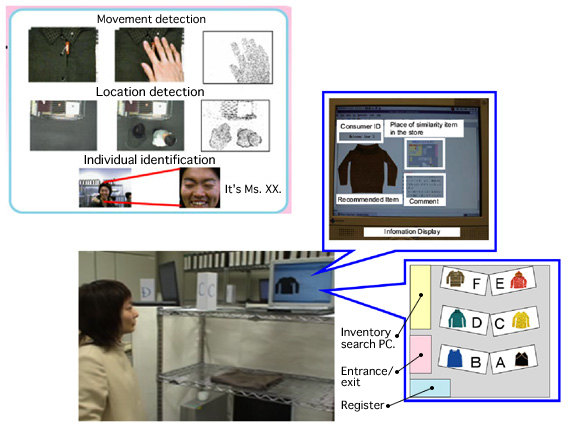Top>Research>Kansei Robotics Bridging human beings and electronic gadgets through kansei engineering
 Index
Index

Toshikazu Kato [Profile]
Education course
Kansei Robotics
Bridging human beings and electronic gadgets through kansei engineering
Toshikazu Kato
Professor of kansei informatics, kansei engineering, computer vision, human interface and multimedia information processing
Faculty of Science and Engineering, Chuo University
1. What is kansei ?
The role of kansei (emotive) engineering.
We, human beings, are sometimes strongly impressed by a grand view, relaxed by a favorite music, upset to inflexible computeres, and convinced, or not, to our friends talk. "Kansei," or in another word, "affection," is a system responsible for your subjective view of the world. This system subjectively interprets various information from other people and objects, and uses this subjective view as the basis for acting upon other people and objects. Kansei can be defined as the system which characterizes the individual personalities.
During the mass-production/mass-consumption society of the 20th century, an important theme for technologies was the low-cost mass-production of high-quality industrial products and information contents. Such technologies assumed their consumers as average human beings, ignoring the differences in kansei between each individual consumer. However, these technologies reached their peak upon entering the 21st century. Now, consumers no longer feel value to industrial products and information contents unless they match to the kansei of their own.
"Kansei" is an important perspective for realizing manufacturing and information service should appeal to each individual consumer. This perspective is supported by the human-centered science and technology of "kansei engineering," or affective engineering.
2. An encounter between kansei and robotics
Now, where can we see the difference of kansei between each individual? A hint for this question is found in the intelligent machinery systems known as robots and in their associated technology, i.e., robotics.
Robots have been developed as the systems which can take place of human beings in hard environments where human beings cannot enter. Robots autonomously observe, think, decide and act. The fundamental information processing functions, which intelligent robots should have, are observation of objects, observation of situations, knowledge base, decision-making and action.
From a robotics perspective, our laboratory have been investigating and modeling the fundamental functions used by human beings for information processing. Thus, we have developed a system and fuctions which can simulate individual differences. In kansei (Figure 1)

Figure 1: Kansei model using a robotics framework
(a) Perception kansei: The process of performing subject perception for information received from objects or media via five senses. This process involves four stages, which are physical level, physiological level, psychological level and cognitive level. For example, different tastes in art and music can be explained by different emphasis and sorting for portions of information when passing through this process in each individual.
(b) Situation kansei: The process in which a person subjectively interprets the situation in which they are placed. For example, even when some people are happen to be at the same time and at the same location, each individual feels a different situation. It may be reasoned that they are evaluating the personal situation considering their own ordinary lifestyles and behaviors of the day.
(c) Knowledge kansei: The association rule and organization amongst knowledge and their collection, i.e., knowledge base within their own memory. It can be reasoned that the vocabularies and their associated organization may differ depending on the personal interests of individual.
(d) Action/Expressive kansei: The process of taking specific action or expressing information, in various media, to the external world through the physical body or an electronic gadget. For example, it can be reasoned that differences in behavior habits (rules) are responsible for skill differences in pursuits such as karaoke and golf, and are responsible for differences in action pattern such as leisurely shopping or rushed shopping.
Finally, we come to the element responsible for linking together the aspects listed above:
(e) Intention kansei: The process of selecting action and expression (output) from sensory images and interpretations of a situation (input). This process is based upon a person's internalized objective. It can be reasoned that differences in lifestyles form the differences in response relationships between input and output.
3. Our understanding of the kansei system has come this far!
Make computers understand your kansei
When performing the modeling of perception kansei, our laboratory also focuses on the neural circuits found in many nerve ganglions including visual and auditory processes. We are simulating the functions of lateral inhibition circuits to apply it to graphical feature extraction as well as learning algorithm.
In particular, in the process spanning from the detection of visual stimuli to the stage of early vision, we have developed a computational model of the lateral inhibitor circuits as high-order local contrast. We have also developed a robust graphical feature extraction method for physiological level description.
Next, we applied this system to image retrieval system, i.e., image search engine, which adopts similar image retrieval in a physiological level, as well as in a psychological level, learning the subjective classification rules of the user. The efficiency and the robustness of this method was demonstrated through an assessment experiment using approximately 14,000 instances of image data. During the experiment, an accuracy of more than 80% was shown for similarity judgments resembling those of human beings (Figure 2). Furthermore, the experiment also showed results regarding links with the image language which is equivalent to the recognition level. When providing sufficient groups of training data (image of a picture and the associated subjective image words), an accuracy of more than 90% was shown for sensory judgments of image language which was the same as the human being. (Figure 3)

Figure 2: Results for automatic discrimination and subjective similarity retrieval from visual key images

Figure 3: kansei retrieval (impression word: fresh and clear) (Reference) Online Demonstration![]()
4. Co-existence of human beings and information environments: A calm information environment
(1) The role of kansei engineering in a ubiquitous information environment
The down-sizing and down-costing of information communication technologies and their electronic gadgets are making it possible to embed a wide variety of computers and sensors into our living environment (a ubiquitous information environment). However, it is not familiar to force a person to understand and make use of inflexible computer systems, to fully enjoy the convenience of such an information environment.
For example, consider the current form of interaction style with information systems. In these systems, the consumer is forced to directly face the interface and respond to questions prompted by the information system. The physical and mental stress felt by the consumer increases together with the number of such interactions. Furthermore, there is also the possibility of obstructing natural action in the living environment.
In order to support a lifestyle which provides personally tuned value and is free from machine-related stress, it is important to superimpose the mechanism for monitoring, storing, and analyzing the personal feature of his kansei, into the living environment It is also important to realize a calm information environment which provides the necessary information services to the user in accordance with the suitable time and place.
While bridging kansei modeling personal information assistance services, we are adopting kansei engineering as the basis for realizing an environment that efficiently supports the lifestyle and activities of human beings (this environment is known as an Augmented Live Sphere).
(2) A Cyber Shop learns consumer's preferences simply by looking
We have deployed and installed a large variety of equipment inside of our laboratory, also known as the Cyber Shop. This equipment includes approximately 50 monitor cameras which are used for detecting time variations such as movement amongst locations and gestures made by human beings. Also installed is image processing equipment, RFID readers, and fixed/portable information presentation devices for the purpose of dynamically stimulating and presenting information to the five senses of human beings.
For consumers, a natural condition is one in which they are not forced to watch the message and not forced to respond to the information system. However, if the consumer finds an interesting product within the shop and related information is presented, it is likely that the consumer will naturally stop to examine the product and read the monitor screen. Conversely, if the consumer is not interested in a product, he will simply ignore it and continue walking.
In our Cyber Shop, by tracing the action of the consumer, the object of the consumer's interest and the degree of that interest is observed and recorded through the consumer's action. As a result, it is not necessary for the consumer himself to directly instruct and respond to the information system. Rather, simply by acting naturally, he can indirectly instruct subjective data for use by the system.
At the present time, if a consumer spends about 15 to 30 minutes walking inside the Cyber Shop, we can categorize the shopping behavior patterns of the consumer at an accuracy of more than 70%. Furthermore, we can estimate the qualities (for example, the color, design, and material of clothing) of products which the consumer will have an interest in at an accuracy of more than 80%. (Figure 4)

Figure 4: Behavior extraction from a consumer at the Cyber Shop
5. Towards new innovations
As a new challenge for kansei engineering, we seeks to realize a living environment (symbiotic living environment) in which natural interaction with the information environment will lead to merits for individuals with wide varaiety of personal features.
This type of research cannot be achieved simply through technological innovations in kansei engineering or robotics. In addition to the fusion of these core technologies, comprehensive advancements are required in a number of fields. For example technology is required for the optimal analysis, structuring and provision of support for needs which exist in the living environment. Other required technology includes the systemization of information infrastructures and social infrastructures, as well as the technology for embedding such systems in the environment and for operating the systems. Furthermore, legal examination must be given to the question of how to solve the tradeoff between convenience and the protection of private information, and proposals must be issued for new social perspectives.
It can be said that technology now considers even the very form of human beings. It has become necessary to evolve from the 20th century style of research and development which emphasized technological innovations into a 21st century style of thinking and action that considers even the aspect of social innovation.
- Toshikazu Kato
Professor of kansei informatics, kansei engineering, computer vision, human interface and multimedia information processing, Faculty of Science and Engineering, Chuo University - Born in Osaka. In 1986, completed the doctoral program majoring in information science at the Kyoto University Graduate School of Engineering. In 1987, he received his Ph. D. dgree on Computer Science from Kyoto University. In 1986, he joined Electrotechnical Laboratory (ETL), at the Agency of Industrial Science and Technology (AIST; currently known as the National Institute of Advanced Industrial Science and Technology), part of the MITI (Ministry of International Trade and Industry). Served as Chief of Interactive Systems Section, Intelligent System Division, and later as Laboratory Leader of the Human Media Laboratory. of ETL In 1997, he became a Professor of the Faculty of Engineering, Chuo University. Since January 2010, has served as Vice-President of Chuo University (in charge of research). He has been a pioneer and leader in research and development for a user-friendly information environment in Japan. He is a member of the Japan Society of Kansei Engineering (Vice-President, Editor-in-chief), the Institute of Electronics, Information and Communication Engineers, the Information Processing Society of Japan, the Architectural Institute of Japan, the IEEE Computer Society and the IEEE SMC.
Human Media Laboratory
- Research Activities as a Member of Research Fellowship for Young Scientists (DC1), Japan Society for the Promotion of Science (JSPS) Shuma Tsurumi
- Important Factors for Innovation in Payment Services Nobuhiko Sugiura
- Beyond the Concepts of Fellow Citizens and Foreigners— To Achieve SDGs Goal 10 “Reduce Inequality Within and Among Countries” Rika Lee
- Diary of Struggles in Cambodia Fumie Fukuoka
- How Can We Measure Learning Ability?
—Analysis of a Competency Self-Assessment Questionnaire— Yu Saito / Yoko Neha - The Making of the Movie Kirakira Megane








